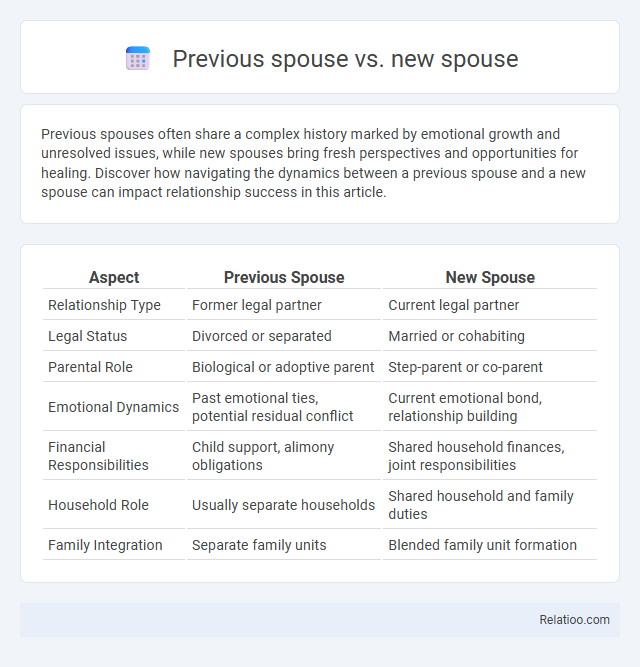Previous spouses often share a complex history marked by emotional growth and unresolved issues, while new spouses bring fresh perspectives and opportunities for healing. Discover how navigating the dynamics between a previous spouse and a new spouse can impact relationship success in this article.
Table of Comparison
| Aspect | Previous Spouse | New Spouse |
|---|---|---|
| Relationship Type | Former legal partner | Current legal partner |
| Legal Status | Divorced or separated | Married or cohabiting |
| Parental Role | Biological or adoptive parent | Step-parent or co-parent |
| Emotional Dynamics | Past emotional ties, potential residual conflict | Current emotional bond, relationship building |
| Financial Responsibilities | Child support, alimony obligations | Shared household finances, joint responsibilities |
| Household Role | Usually separate households | Shared household and family duties |
| Family Integration | Separate family units | Blended family unit formation |
Understanding the Dynamics: Previous Spouse vs New Spouse
Understanding the dynamics between a previous spouse and a new spouse centers on navigating emotional boundaries and establishing trust while addressing lingering attachments and unresolved conflicts from past relationships. Clear communication and mutual respect foster loyalty and reduce tension, enabling both partners to prioritize the current relationship over past connections. Recognizing each individual's needs and maintaining transparency about commitments can mitigate loyalty conflicts and promote relational stability.
Emotional Baggage: Navigating Past Relationships
Emotional baggage from a previous spouse can create challenges in trust and communication with a new spouse, impacting relationship dynamics. You must recognize and address unresolved feelings or conflicts from past relationships to build a healthy, loyal partnership. Effective emotional management fosters loyalty and minimizes conflicts stemming from past relationship experiences.
Trust Building with a New Partner
Trust building with a new partner often faces challenges due to lingering loyalty conflicts linked to a previous spouse. Emotional baggage and past relationship dynamics can create barriers that necessitate transparent communication and consistent actions to establish reliability. Prioritizing mutual respect and demonstrating commitment help dissolve insecurities and foster a strong foundation for trust in the new relationship.
Communication Challenges and Solutions
Communication challenges in relationships with a previous spouse, new spouse, and loyalty conflicts often stem from unresolved emotions, divided attention, and conflicting expectations. Establishing clear boundaries, practicing active listening, and fostering open, honest dialogue helps mitigate misunderstandings and rebuild trust among all parties. Utilizing mediation or couples counseling can provide structured communication techniques and emotional support, promoting healthier interactions and resolution.
Blending Families: Integrating Children and Stepchildren
Blending families often involves navigating loyalty conflicts between your previous spouse and new spouse, especially when integrating children and stepchildren. Establishing clear communication, setting consistent boundaries, and fostering mutual respect help minimize misunderstandings and promote harmony among all family members. Prioritizing the emotional well-being of children encourages positive relationships and smooth transitions within the restructured family unit.
Financial Considerations: Past vs Present
Financial considerations in conflicts between a previous spouse and a new spouse often revolve around balancing past obligations with present responsibilities. Your current financial commitments can be complicated by alimony, child support, or shared assets from a previous marriage, requiring careful budgeting and transparent communication. Managing these competing priorities is essential to maintain stability and fairness in your household.
Boundaries: Managing Relationships with Ex-Spouses
Maintaining clear boundaries with a previous spouse is essential to prevent loyalty conflicts in new relationships, ensuring respect and trust with your new partner. Setting limits on communication, establishing rules for co-parenting, and defining personal space help manage expectations and reduce tension. You can protect your relationship by prioritizing transparency and avoiding situations that blur the lines between past and present partnerships.
Social Stigma and Acceptance
Navigating loyalty conflicts between a previous spouse and a new spouse often intensifies due to social stigma and varying levels of acceptance from family and community. Your relationships may be scrutinized based on cultural norms, where loyalty to a previous spouse is sometimes viewed as a barrier to fully embracing the new partnership. Building mutual respect and seeking supportive networks can help mitigate social pressures and foster acceptance in blended family dynamics.
Cultivating Healthy Co-Parenting Relationships
Navigating loyalty conflicts between your previous spouse and new spouse requires clear boundaries and open communication to prioritize children's well-being. Establishing mutual respect among all parties fosters a cooperative environment, reducing tension and promoting consistent parenting. You can cultivate healthy co-parenting relationships by focusing on shared goals, empathy, and maintaining positive interactions for the children's emotional stability.
Personal Growth: Lessons Learned from Previous and New Marriages
Navigating the loyalty conflict between your previous spouse and new spouse can significantly impact personal growth by teaching resilience, communication, and emotional intelligence. Lessons learned from past marriages often include recognizing patterns, setting boundaries, and fostering trust, which are crucial for building healthier relationships moving forward. Embracing these experiences allows you to cultivate a deeper understanding of yourself and your needs within a new partnership.

Infographic: Previous spouse vs New spouse
 relatioo.com
relatioo.com